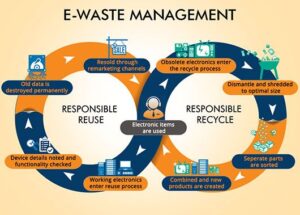E-waste is one of the fastest and exponentially growing waste streams because global consumer demand continues to increase day-by-day. As many parts of our expanding world cross over to the other side of the ‘Digital Divide,’ the contemporary consumer demands the means to enjoy an easier more comfortable lifestyle. However, that very understandable demand creates a downstream problem of safe e-waste disposability. Moreover, technology upgradation, uptake, and shorter replacement cycles are contributing to the growth of e-waste.
Some of the facts that report alarming rate of e-waste accumulation into the environment are included in this section:
• In 2017, the Global E-waste Monitor shows that e-waste has increased to 44.7 million metric tonnes per annum.
• A mere 20% of the e-waste generated is documented to be collected and recycled.
• The fate of 76% (34.1 million metric tonnes) of e-waste is unrecorded. This might have been dumped in landfills and traded or recycled under inferior conditions.
• Moreover, most of the e-waste remains in the sheds, attics, garages, cellars, and storage rooms of its owners or gets disposed-off into the normal household bin.
• In developing countries, unsafe handling of e-waste results in harm to human health and the environment. For example, open-air burning and acid baths used to recover valuable materials from electronic components exposes workers to harmful substances.
• Additionally, rudimentary methods are being used to recover valuable components while hazardous components are disposed of in uncontrolled landfills and ocean waters creating ecological endangerment.
• The dangerous minerals and toxic materials include silicon, beryllium, arsenic, cadmium, mercury, lead, chromium, brominated flame retardants, and polychlorinated biphenyls (PCBs). Health hazards occur from inhalation of the toxic fumes as well as from the accumulation of chemicals in soil, water, and food.
• The poisonous metal leaching can lead to irreversible health effects, including cancers, miscarriages, neurological damage, and diminished IQs.
• Today, in addition to products that have stopped working or become obsolete, even properly working products are being disposed-off without second thought. Technological advances at dizzying speed are replacing many products that are still functional and usable.
• Virtually all electronic waste contains some form of recyclable material. That includes materials like plastic, glass, and metals.
E-waste management measures at global level:
In recent times, the e-waste problem escalated into a great global concern and challenge because of the nature of production and disposal of waste in a globalized world. E-waste is particularly dangerous due to toxic chemicals that naturally leach from the metals, plastics and inside components when they are buried into soil or in contact with ground and fresh water resources. This raises concerns about resource efficiency as well as the immediate concerns of human health and the environment. However, many countries have recognised the need to properly recycle e-waste and are working on implementing sustainable solutions. International cooperation and coordination are supporting this process in order to ensure the opportunities for different circumstances and are offering ultimate facilitation through global recycling chains.

(picture courtesy: global e waste managemnt – Bing images)
E-waste management measures at individual level:
The recycling of e-waste serves a lot of useful purposes. For instance, protecting human and environmental health by keeping electronic and electrical devices out of landfills. It is the responsibility of consumers to dispose the e-waste through proper channel of recycling process. This helps to recover the valuable and functional parts within the devices and provide the manufacturers with recycled metals and components that can be used to make new products. Ultimately, a proper environment-friendly e-waste collection and recycling process needs to be put in place to protect us and future generations.
